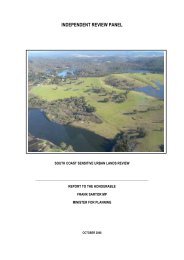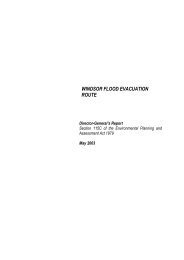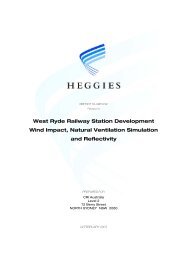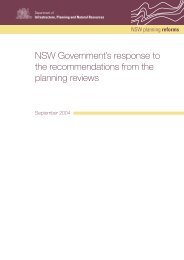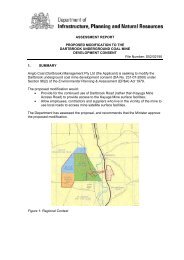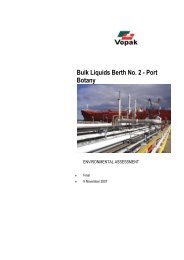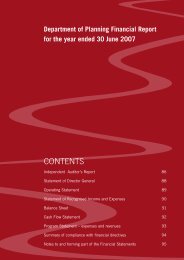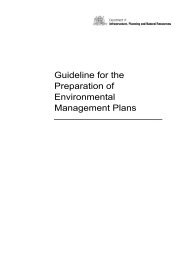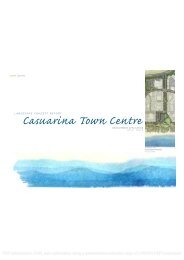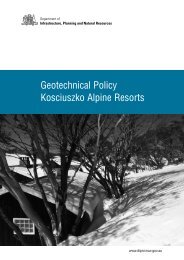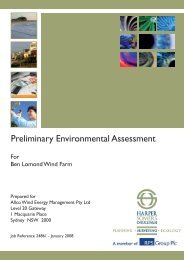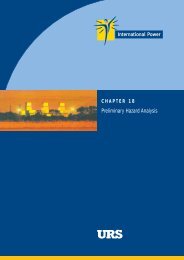Appendix P Drainage, Flooding, Stormwater Management Part 5
Appendix P Drainage, Flooding, Stormwater Management Part 5
Appendix P Drainage, Flooding, Stormwater Management Part 5
Create successful ePaper yourself
Turn your PDF publications into a flip-book with our unique Google optimized e-Paper software.
<strong>Flooding</strong>, <strong>Drainage</strong> and <strong>Stormwater</strong> <strong>Management</strong><br />
Sanctuary Villages<br />
Existing peak discharges at Millfield Bridge for the 5 and 20 year ARI storm events are<br />
generally in close agreement with estimates documented in the Wollombi Valley Flood<br />
Study prepared by Patterson Britton and <strong>Part</strong>ners (April 2004). The predicted 100 year<br />
discharge is 17% larger than that documented by PBP. This may be due to variations in<br />
the height-storage-discharge relationship adopted by both Consultants.<br />
A summary of existing peak discharges, peak storage and peak water level at Ellalong<br />
Lagoon (node QUO.7) for the 1, 5, 10, 20, 50 and 100 year ARI storm event is provided<br />
in Table 3-3, and will be used as a baseline comparison for evaluating the impacts of the<br />
development on existing flow rates, as well as for estimating the 100 year ARI flood levels<br />
within the study area.<br />
Table 3-3:<br />
ARI<br />
Existing peak discharge, peak storage and peak water level in Ellalong Lagoon<br />
Existing Peak<br />
Discharge (m 3 /s)<br />
Critical Storm<br />
Duration (min)<br />
Peak Storage<br />
(ML)<br />
Peak Water Level<br />
(m AHD)<br />
1 Year 16 720 473 111.23<br />
5 Year 64 2160 1,560 112.35<br />
10 Year 80 2160 1,560 112.84<br />
20 Year 141 2160 2,820 113.34<br />
50 Year 231 2160 3,030 113.51<br />
100 Year 305 2160 3,160 113.62<br />
3.2 Developed hydrology<br />
3.2.1 Potential hydrological impacts of development<br />
Urban development typically results in an increase in the impervious surfaces within a<br />
catchment and engineering works to collect and convey runoff. Without appropriate<br />
management, several potential impacts result from development. These could include:<br />
<br />
<br />
<br />
increased frequency of runoff events;<br />
increased runoff volume, peak flow and velocity; and<br />
decreased groundwater base flows and lowering of the watertable.<br />
These impacts may in turn lead to:<br />
<br />
<br />
<br />
<br />
inundation of downstream property and infrastructure;<br />
change in existing channel form and sediment transport;<br />
damage to riparian and aquatic vegetation; and<br />
damage to existing aquatic ecosystems and natural wetlands.<br />
3.2.2 Model parameters<br />
The effect of urbanisation, of the proposed development site, was modelled using XP-<br />
RAFTS and involved the inclusion of impervious areas within the existing model. The<br />
model was then used to estimate developed peak flow rates at Millfield Bridge (node<br />
CON.15).<br />
PARSONS BRINCKERHOFF 2122870A-PR0116 Page 12



